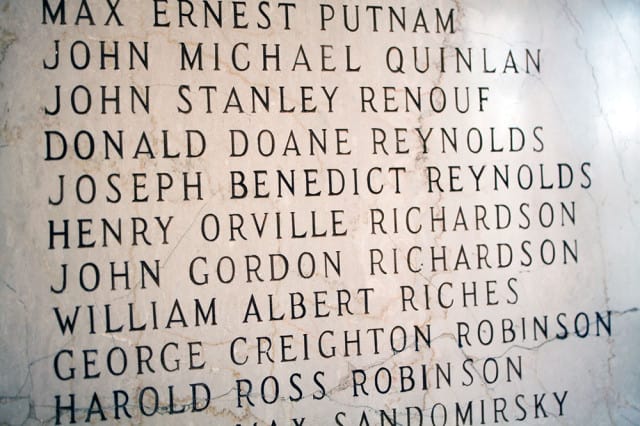
The Memorial Wall in Louis’ Loft lists the names of 202 students and graduates who gave their lives in the Second World War.
Less than a decade after the university first opened its doors to the people of Saskatchewan, its students, faculty and staff were thrust into the First World War and would remain a lifeline for the Canadian military through to the end of the Second World War.
On Aug. 4, 1914, Great Britain declared war on Germany. By Nov. 1 of that same year, the first draft of student recruits boarded the train to Winnipeg where they would commence their training.
With WWI well underway by February of 1916, the Western Universities Battalion sent off the second wave of students and faculty from the four western provinces. By October, the University of Saskatchewan had sent 168 students, 11 staff members and eight others connected with the university.
Upon arriving in England, the battalion was divided up to support existing units. Many found themselves in the Saskatchewan-dominated 46th Battalion — known as the “Suicide Battalion.” Of the 5,374 people who served in the battalion, 4,917 made the ultimate sacrifice.
The then School of Engineering closed temporarily during the 1916-7 academic year when its students and faculty members enlisted en masse.
Come the end of WWI, 342 students, staff and faculty members had enlisted in the Canadian military of which 67 never returned. Medals of valour were awarded to 33 enlistees while 100 had been wounded.
With the agonies of WWI still fresh, students were reluctant to once again answer the call to arms when a second global conflict became imminent in the 1930s. However, students and faculty members saw that fascism and Adolf Hitler’s dictatorship were a greater threat than their own suffering during the Great Depression and they once again joined the ranks of the Canadian military.
The Government of Canada sent out a request that any students studying sciences, agriculture, engineering or medicine complete their education before leaving to fight. To prepare students with an academic education as well as military training during this time, the Canadian Officers Training Corps was formed. Students could prepare for examinations for the commissions of lieutenant or captain as a part of their undergraduate studies. COTC work counted toward course credits. Faculty members could hold senior positions while junior and non-commissioned ranks were open to all undergraduate students.
The U of S Squadron Royal Canadian Air Force was established in 1948 and surpassed 400 student members by 1960 when they had over 100 active members.
Students preparing to qualify for the navy reserves joined Navy on Campus, where they took part in training for careers with the Royal Canadian Navy. During the winter, students trained at HMSC Unicorn — a naval reserve in Saskatoon — and spent their summers on either of the country’s two coasts.
To show respect, the U of S has memorials dedicated to those who lost their lives installed across its campus and built into its walls.
In 1916, the university’s Board of Governors decided to create a Roll of Honour with “the names of all students and others connected with the university who have enlisted, painted on the ‘ribbons’ in the corridors” of the Peter MacKinnon Building.
On May 3, 1928, the Memorial Gates were unveiled and dedicated to the 67 students and faculty members from the U of S who lost their lives in the Great War of 1914-18. The president of the university at the time, Walter Murray, read every name engraved on the memorial tablet. The tablet also bears the words: “These are they who went forth from this University to the Great War and gave their lives that we might live in freedom.”
On Remembrance Day in 1933, a bronze memorial plaque was dedicated to the men and women from the U of S who served with the 46th Battalion in France and Flanders from 1916 to 1918.
Dedicated to the students, staff and faculty members of the U of S who served in WWI and WWII, the Memorial Union Building opened on Remembrance Day in 1955.
The construction of the MUB began in 1953 and it has the distinction of being the last building to be built on the U of S campus in the collegiate gothic style.
On the upper floor of the MUB, where Louis’ Loft is currently located, the Memorial Wall is the focal point of the room. The Memorial Wall is engraved with the names of the 202 students and graduates who gave their lives in WWII.
A memorial service will be held in front of the Memorial Gates at 1:15 p.m. on Nov. 11 and is open for all to attend.
—
Photo: Jordan Dumba/Photo Editor